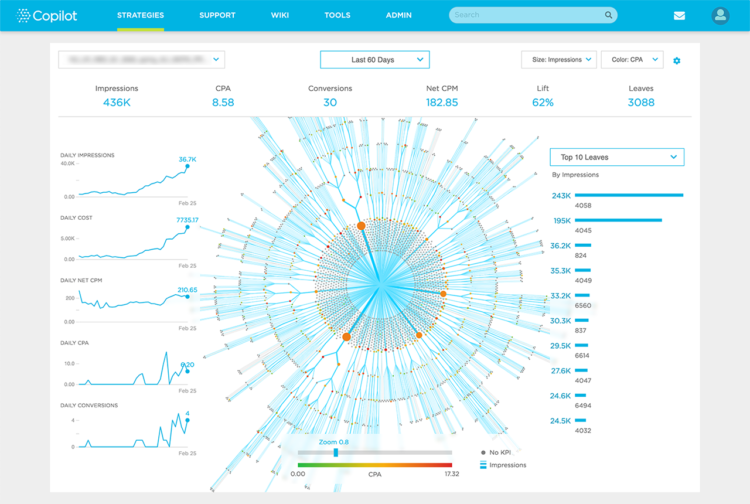Brands know they need artificial intelligence, and their programmatic advertising partners know they would have a hard time working without it.
But as data volumes grow exponentially and AI speeds up its ability to process this data through machine learning, a glaring issue for marketers has been a lack of clarity in understanding how the AI is working. Marketers want to see where their money is being spent and why. Just saying that “AI optimized it” won’t cut it.
Data visualization can play a big role in helping to distill the complexity of multiple metrics and processes into a visually appealing presentation that can be quickly understood and then delved into for further detail. Our Copilot team, which develops proprietary technology at Xaxis, has been working to make AI more accessible for a few years. I’m tasked with translating our bespoke AI models into visualizations that provide insights for agencies and brands.
A good visualization communicates the truth in data, but which truth depends on what is being communicated, and to whom. To effectively design a visualization is to know the data intimately but, more important, to understand the needs of the audience it is speaking to. The audience of the visualization must be top of mind when designing.
For example, a visualization designer should consider:
- ¿Es necesario mostrar los datos a lo largo de un periodo de tiempo?
- ¿Qué métricas son las más importantes?
- ¿Qué áreas de una visualización tienen que "saltar"?
Construir una visualización, en la práctica
Recientemente, lanzamos algunas nuevas visualizaciones de datos para explicar una de nuestras estrategias algorítmicas, mostrando masas de decisiones no humanas de una manera fácilmente digerible y no trivial.

El gráfico de esta página capta una gran cantidad de resultados complejos de una manera que un ser humano puede comprender rápidamente: cómo el coste por acción (CPA) de las impresiones compradas disminuyó incluso cuando el número de impresiones aumentó y su precio (representado por el CPM) se mantuvo relativamente plano. En los círculos concéntricos se puede ver cómo la IA fue capaz de gestionar el proceso a medida que la orientación de los anuncios pasaba de los CPA y los KPI limitados a concentrarse en las impresiones que tenían un buen precio. y fueron eficaces.
La visualización de datos puede ser similar a las prácticas tradicionales de diseño UX. Tanto el diseño UX como la visualización de datos implican la investigación de los usuarios, el modelado de los casos de uso, las entrevistas con el público al que va dirigido y muchos diseños de prueba. Este proceso muestra al diseñador qué información busca el público y revela las preguntas a las que debe responder el diseño.
La visualización de datos como arte
Despite protest from some within the data visualization community, I consider data visualization to be the art of the computer science world. The aesthetic aspect of design is an essential component of strong visualizations. Practitioners of data visualization should consider the artfulness of our work.
Being artful doesn't diminish the value of a visualization. Rather, it allows it to transcend the data and captivate the spirit. Doing so requires a deep focus on both highlighting the right data for a given audience and respecting the art of design.
Color choice, spacing, and movement should all be top of mind when working with data. Beautiful visualizations are comprised of numbers and formulas that inform shapes and colors.
There are great lengths to go to in order to further improve how we visualize the bounties that AI and machine learning can bring. A focus on both relevant data and aesthetics will ensure that this discipline will continue to bring tremendous value to marketers.




